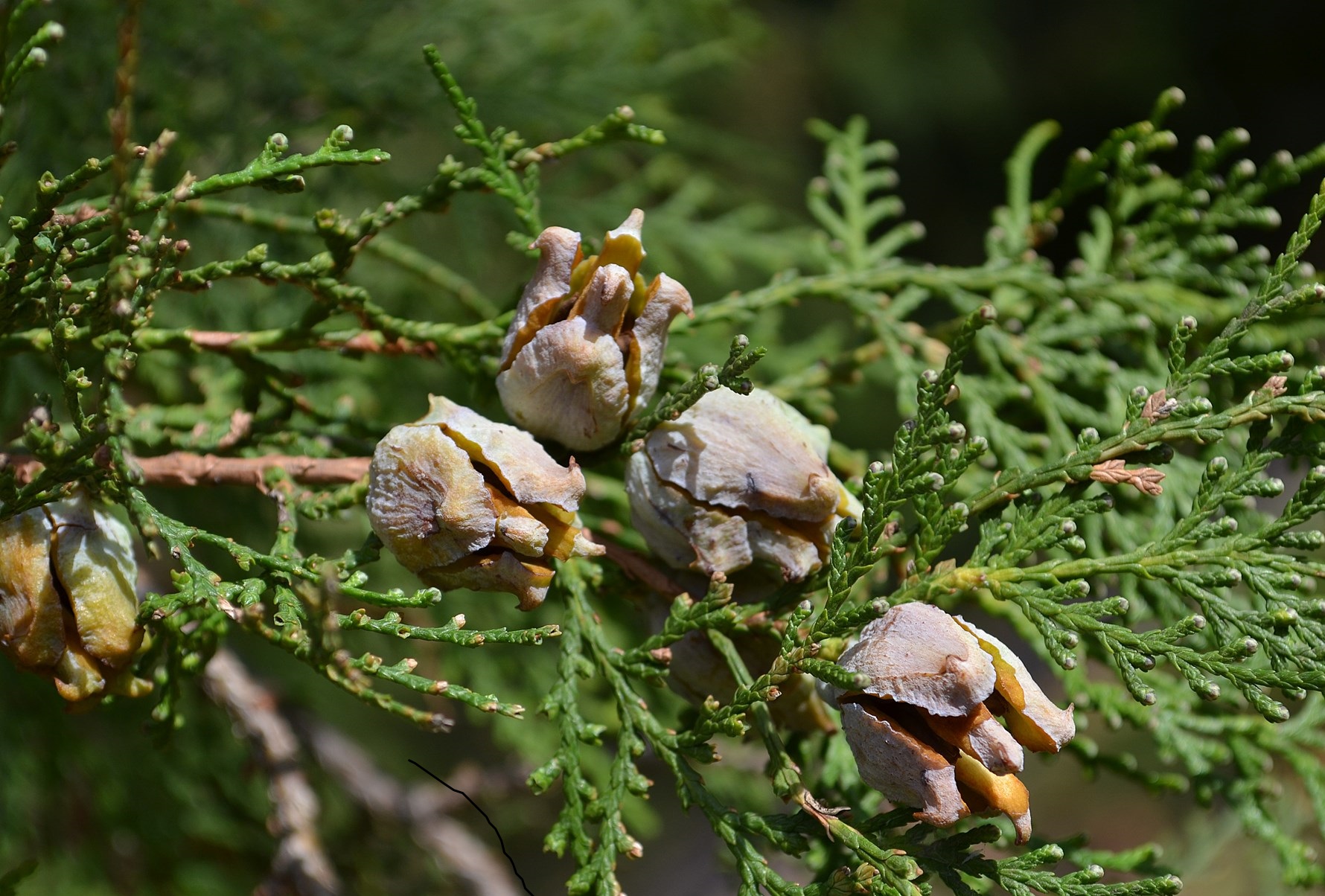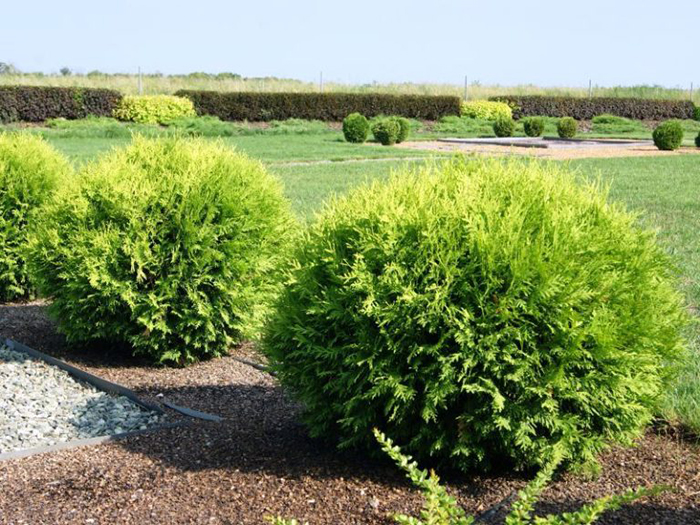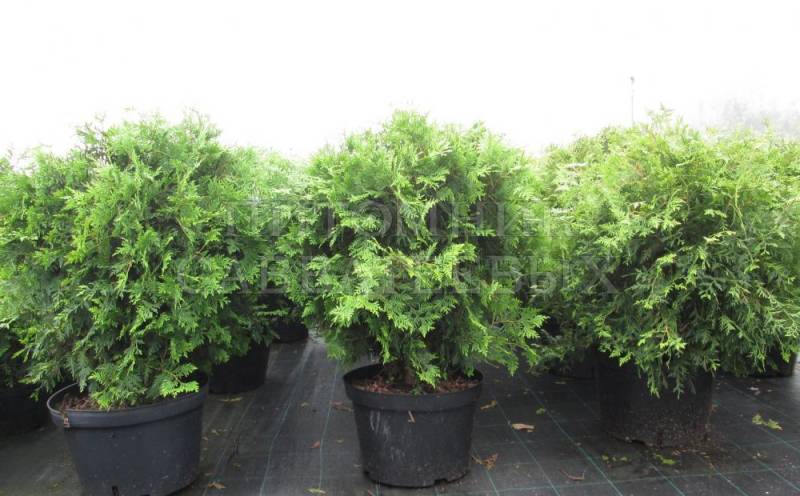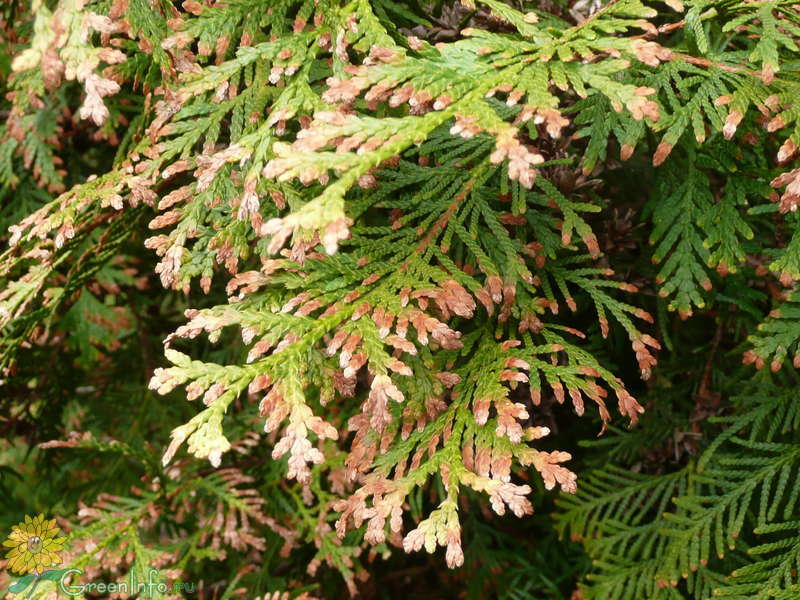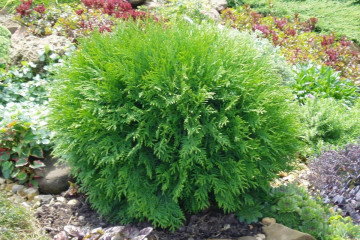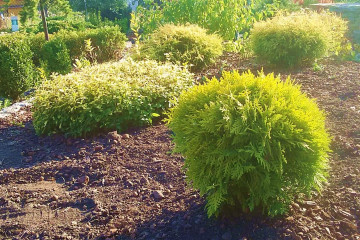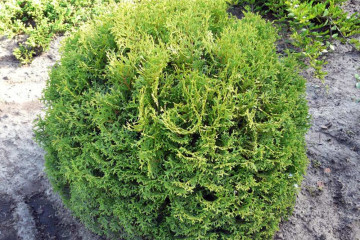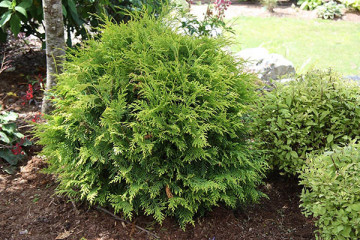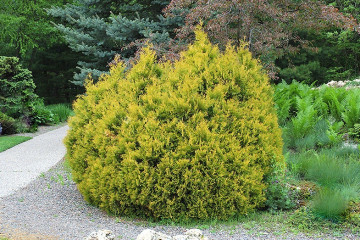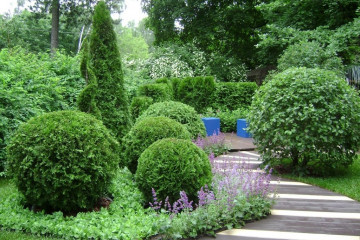Thuja Globoza (Globosa) western spherical - description
Content:
Western thuja Globoza (Globosa) is a very beautiful small shrub with a spherical crown. It is very popular all over the world. It is a key ornamental shrub in landscape design.
Thuja Globoza (Globosa): description
The compact coniferous shrub thuja Globosa (Globosa) appeared in the middle and northern latitudes of East Asia. Belongs to the Cypress family. The dwarf bush grows no more than one meter in height. Spherical thuja is quite resistant to frost and disease, so it is not difficult to grow it.
The description of Globoza and other types of thuja is not very different. A small neat dense tree has the shape of a ball. Its small coniferous branches have dense green scales.
In winter, the color of the scales becomes brownish. The thuja has a very dense crown, such an effect is created due to the crossing branches. There are small cones on the surface of the branches, no larger than 1 centimeter.
The shrub grows very slowly, every year it grows by only 4-7 centimeters. As a result, a shrub that is about 20 years old grows no higher than 1.5 meters.
Planting and caring for thuja Globoza
Thuja globose is a very unpretentious and easy-care plant. If you provide it with all the necessary conditions, it will grow well with minimal attention. The plant is cold-resistant, so planting and care in middle and northern latitudes is quite possible.
How to plant thuja Globoza
The optimal time for planting western thuja Globosa is spring or autumn. A place for planting must be chosen with good soil moisture. It is not recommended to choose completely open areas, let them be with partial shade. It is better to avoid open places on the north side, cold penetrating drafts adversely affect the plant. Grows well in fertile and loose soils.
Before planting seedlings in the ground, it is necessary to clear the area, if necessary, you can dig it up. The depth of the hole depends on the size of the earthen ball that envelops the root system of the seedling. If a drainage layer is covered at the bottom of the hole, then it must be dug out 10-20 centimeters deeper.
Each seedling should be well checked for damage or infection. The roots of a healthy thuja should be white. Each seedling is placed in a separate hole and sprinkled with a mixture of fertile soil, river sand, peat and humus. It is not necessary to deeply deepen the bush into the ground - the border of the beginning of the roots should be at the level of the top layer of the earth.
Watering mode
Watering should be regular but moderate. It is enough to water the shrub twice a week. It is useful to loosen the soil after each watering in order to prevent moisture stagnation. Strong humidity leads to the formation of fungal diseases and mold, which has a detrimental effect on the coniferous plant.
In addition to watering, it is necessary to spray the ground part of the bush. Sprinkling should be done less frequently and not as abundantly as watering so that the plant does not get sick.
Top dressing
For the formation of a lush crown, the thuja must be regularly fed with mineral and organic fertilizers. Feeding is especially necessary in the first years of active growth. Young seedlings, unlike adult bushes, are not able to extract all the nutrients necessary for growth from the soil.
The first feeding is carried out when planting a seedling. This top dressing is the most important of all the following, it must be complete and include minerals along with organic ones. The role of organic matter can be stale manure, rotted humus or compost. At the bottom of the planting hole, in addition to organic matter, nitrogen and phosphorus fertilizers are applied.
Further feeding is carried out every spring and autumn, during the first 3-5 years. In the spring, the composition of the dressing should include the following elements:
- phosphorus;
- calcium;
- nitrogen;
- magnesium;
- manganese;
- potassium;
- iron;
- zinc.
Top dressing is carried out with superphosphate, ammonium nitrate, potash fertilizers and other means. However, it is more effective to purchase complex preparations specifically for thuja or plants of the cypress family, which are sold in specialized stores.
In the fall, feeding of coniferous thuja is carried out with Fitosporin. As soon as thuja Globoza gains growth and gets stronger, feeding is carried out once a year - in the spring.
Features of summer care
In the summer, thuja western Globoza requires the care of the following species:
- mulching;
- pruning shoots to form the crown;
- regular watering;
- loosening the soil.
Otherwise, thuja does not require special attention in summer.
Preparing thuja Globoza for winter
The shrub needs preparation for the winter. First, spruce branches are laid around the trunk in the root zone. This procedure insulates the roots and prevents pests, especially rodents, from appearing.
The crown is trimmed, all dried and rotten, as well as excess shoots are removed. In order for the snowdrifts not to damage the ground part of the bush, it is necessary to build a special frame around it. On top of this structure or below it, the thuja is covered with a protective material: agrofibre or polyethylene.
Reproduction of thuja Globoza
Thuja globose globose takes root well when propagated by cuttings. It is this method that is most in demand among experienced gardeners and beginners. In addition to propagation by cuttings, thuja can be propagated by the vegetative method and with the help of seeds.
Propagation by cuttings
With the help of cuttings, you can get as many bushes as you want. The procedure is best carried out in the fall, so that they have time to give roots and not dry out. Before cutting the cuttings, it is necessary to prepare the room where they will take root. A design in the form of a small greenhouse is well suited for this. In advance in the greenhouse, you need to prepare the necessary humidity - at least 70%.
They choose strong, large shoots, which are at least 3 years old, at the base of this shoot must necessarily have a so-called "heel" - a small part of old wood. Cuttings are cut near this "heel", all needles on the lower part of the cutting are removed.
Cuttings are planted in the finished substrate, which had previously been kept in water for several hours. The cuttings are deepened into the ground to the border, where the needles begin to grow. The coniferous part should not touch the ground, so that rotting of the cutting does not begin.
If young shoots begin to appear in the cuttings, then the development of the root system has begun. Now you can periodically air the cuttings, thus gradually hardening the seedlings.After a while, the seedlings are taken outside for a short time every day. It is at this time that watering begins, so the seedlings will be most hardened, before planting them in open ground.
Why does thuja Globoza turn yellow
Thuja Globoza's resistance to diseases is very high, but sometimes it starts to hurt. First of all, harmful environmental influences are reflected in the condition of the ground part of the bush. These signs are caused by unfavorable climatic conditions and / or improper maintenance.
Some gardeners are faced with the problem of yellowing and browning of the thuja crown. This happens most often in the spring. Changes in the foliage of bushes can occur due to improper shelter for the winter.
Some shelter materials can create a greenhouse effect inside and worsen the condition of the bush. They let in ultraviolet rays, the temperature inside heats up, because of the dense material, ventilation of the air does not occur. If the problem of yellowing is associated with improper shelter for the winter, in the spring, the same Globoza is watered with biostimulants so that the plant begins to actively develop.
The problem can arise in the summer, the reason lies in the stagnation of moisture in the soil. Most likely, the plant was watered abundantly or groundwater passes nearby. In addition to yellowing of coniferous scales, mold and fungus may appear in the root zone. To avoid this problem, it is necessary to loosen the ground after each watering. The base of the trunk must be treated with an antifungal agent, and the damaged branches must be cut off with pruning shears.
Decorative western thuja, thanks to its spherical dense crown, will decorate any garden. With the help of cropping, you can create any shapes from it at your discretion. Many plant thorny compact spruce Glauka and thuja Globoza nearby - the plants are similar in shape and, when alternating, create an amazing composition.

